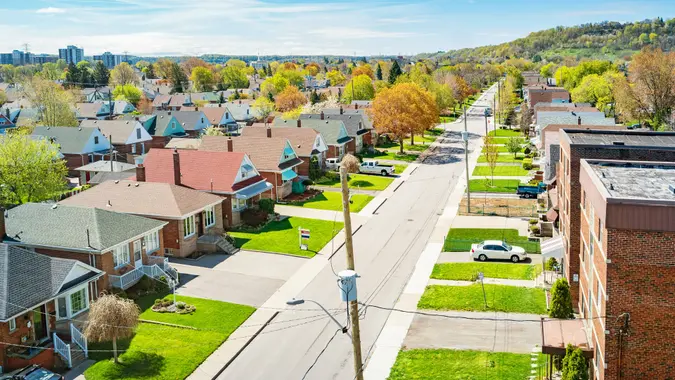4 Policies From Trump’s First Term That Hurt the Middle Class’ Ability To Build Wealth

Commitment to Our Readers
GOBankingRates' editorial team is committed to bringing you unbiased reviews and information. We use data-driven methodologies to evaluate financial products and services - our reviews and ratings are not influenced by advertisers. You can read more about our editorial guidelines and our products and services review methodology.

20 Years
Helping You Live Richer

Reviewed
by Experts

Trusted by
Millions of Readers
President Donald Trump has famously pledged to “make America great again.”
However, that pledge did not extend to many middle-class Americans, said Christopher Stroup, founder and president of Silicon Beach Financial. “During Trump’s first term, policies like tax cuts for corporations and the wealthy, deregulation and healthcare changes favored the rich. These efforts increased some inequality across the board.”
Here are four policies from Trump’s first term that hurt the middle class’ ability to build wealth.
Temporary Middle-Class Tax Cuts
The Tax Cuts and Jobs Act (TCJA) of 2017 was one of Trump’s signature achievements during his first term. While many tax cuts are set to expire this year, Trump consistently advocated for extending or making most of the tax cuts permanent.
“While the tax cuts were temporary for individuals, they disproportionately benefited the wealthy, hindering the ability of the middle-class to grow their wealth,” Stroup explained.
According to a 2017 Tax Policy Center analysis, 83% of the benefits would be seen by the top 1% of taxpayers by the time the law was fully enacted, while middle-income taxpayers would see no significant change to their taxes.
“The law’s long-term effects include widening income inequality, which limits wealth accumulation opportunities for the middle class,” Stroup said. “It also has led to a substantial increase in the federal deficit.”
Higher Healthcare Costs
Through executive and legislative actions, Trump tried, but failed, to eliminate the Affordable Care Act (ACA).
However, Trump made it more difficult for Americans to sign up for health insurance by cutting funding for ACA advertising from $100 million to $10 million and reducing enrollment assistance from $62.5 million to $37 million. He also halved the open enrollment period for ACA from 90 to 45 days, including being closed on Sundays, The Commonwealth Fund reported.
According to data from the Congressional Budget Office (CBO), these and other related Trump administration changes led to 19 million fewer people having access to healthcare in 2020.
In addition to fewer people having access to the health exchange, those who did paid an average of 20% more in premiums, according to the CBO, because the first Trump administration ended cost-sharing reimbursements to insurers.
“Trump’s attempts to repeal the Affordable Care Act and cut subsidies increased healthcare costs for many middle-class families,” Stroup said. “With higher premiums and fewer protections, families were faced with financial strain. This often resulted in a limited ability to save and build wealth over time.”
Rising Federal Debt
The Committee for a Responsible Federal Budget, a nonprofit government watchdog, concluded that Trump contributed to $8.4 trillion in ten-year debt through legislation and executive actions that were offset by a unilateral expansion of tariffs.
Wayne Winegarden, an economist at the Pacific Research Institute, said Trump failed in the areas of rising debt levels and controlling total government spending during his first term.
“He spent recklessly during the pandemic, which, when combined with the huge spending during the Biden administration, has put the federal government in an incredibly shaky financial position,” Winegarden said.
Rising federal debt matters to the ability of middle-class families to build wealth, because higher debt leads to increased interest rates, making it harder for families to afford a home.
“The higher rates reduced housing affordability,” Winegarden said. “The government’s poor financial management may encourage tax increases that will reduce people’s incomes and jeopardize programs such as Social Security and Medicare.”
Inaction on Social Security
Trump has consistently said he wouldn’t “touch” federal entitlement programs that many middle-class retirees depend on to meet their daily expenses, such as Social Security.
However, the Social Security Trust Fund faces a shortfall and could be depleted in a decade. If Congress and the president do nothing, then retirees would only get 83% of their benefits. While the Social Security shortfall didn’t hurt middle-class retirees during Trump’s first term, it might have consequences over the long term.
“The unwillingness to reform Social Security and Medicare is another failure that he seems to be repeating,” Winehouse said. “The problem is that without reform, middle-income families are facing the prospects of large cuts in these programs — not reforming the programs is essentially guaranteeing cuts to future families’ benefits.”
Winegarden explained, “It also will require future tax increases that will be harmful to families.”
Editor’s note on political coverage: GOBankingRates is nonpartisan and strives to cover all aspects of the economy objectively and present balanced reports on politically focused finance stories. You can find more coverage of this topic on GOBankingRates.com.
More From GOBankingRates
 Written by
Written by  Edited by
Edited by 

























